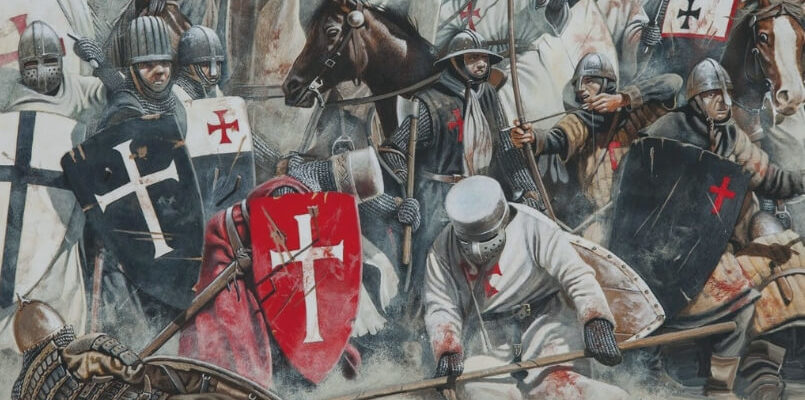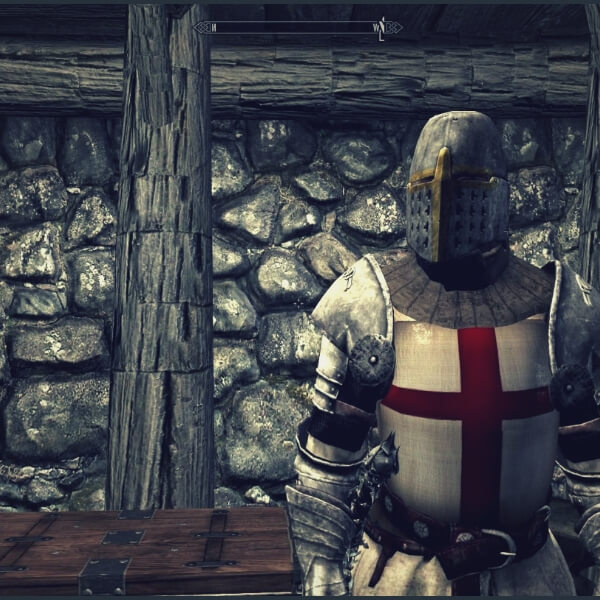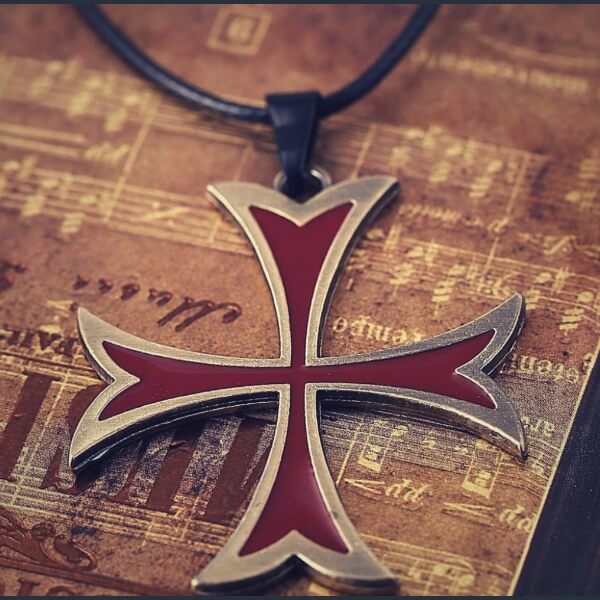Who are the Templars: a brief history of the great order.

Who are the Templars? How did they achieve greatness? Read on!
One of the most popular historical themes, filled with mystery, drama, and intrigue, is the theme of the Templars, the keepers of the Temple of King Solomon and the champions of Christianity in Jerusalem.
Chances are, you’ve seen the Templars in movies, read about them in novels, or followed them through computer game scripts. But none of this can come close to the truth about the great order, which we still do not fully know.
One thing is for sure: this story began with a group of nine knights and ended with one of the most powerful financial and military organizations ever created.
After reading the article to the end, you will find out:
- The history of the Templars;
- Who are the Templars and what did they do?
- The historical significance of the Knights Templar.
It is known from the history of the order that the Templars protected great secrets, too dangerous for wide publicity.

These mysteries could destroy the stability of the Catholic Church, as well as any other religion that relies on the story of Jesus Christ as presented in the Bible.
The Templars’ connection with the Holy Grail runs through the history of the order. The theory of what they knew about Jesus’ descendants has been speculated for far longer than most people realize.
For those interested in the Tarot: take a close look at the Chariot card from Aleister Crowley Thoth’s deck. You will discover the theory of the origin of the blood of Jesus. Of course, if you want to dig deep enough.
Who were the Templars?
We all know that the Middle East is a source of tension, territorial disputes, and wars. This fact is nothing new.
So it was in the Middle Ages when the Crusades were carried out in an attempt to recapture Jerusalem from the Muslim conquerors.
Jerusalem was of great importance at that time. It was the sacred center of Judaism, Christianity, and Islam.
Control over Jerusalem was believed to be an indication of the divine right to rule. He was recognized by both the East and the West.
The Crusaders took back Jerusalem in 1099. Control over the city was extremely difficult. It was necessary to use military force to protect and maintain order. For these purposes, the Templar Society was created.
Hugues de Payens, a French knight and nobleman, became the first Master of the Templars. The group originally consisted of nine knights. Eventually, they will number in the thousands. This is how the history of the Knights Templar began.
Why were they called the Templars?
The name comes from the fact that the knights believed that they originally camped where the temple of King Solomon used to be. “Knights Templar” simply means “Knights of the Temple”.
A more correct name for the order would be: “Poor Soldiers of Christ and the Temple of Solomon.”
What did the Templars do?
In addition to maintaining control of the Holy Land, one of the main duties of the early Templars was to escort pilgrims from Europe to Jerusalem and back.
Christian pilgrims were very numerous, and travel at that time was very dangerous. The roads were teeming with robbers and murderers.
Pilgrims without protection were easy prey for bandits and were often victims of violence. The Templars were well trained and honest. As a formidable fighting force, they were feared and respected.
In addition to escorting people and goods, the Templars devised an ingenious plan to prevent large sums of money from being transported across hostile territories.
Some consider this to be the first step towards a modern banking system. The idea was surprisingly simple.
Money was given to the Templars in the city of departure by a pilgrim or a member of his family. The Templar administrators issued a document confirming this fact.
Upon arrival in Jerusalem or another city, the pilgrim handed the document to the local Templars, and they gave him the money.
It is worth noting that the Templars levied an administrative fee for the services rendered.
This could not be called selfish interest, since usury was considered a sin. But somehow, the administrative fees helped create a wealth of the Templars that soon became unprecedented.
How else did the Templars get rich?
Over time, it became more difficult to get into the Templar society. When a nobleman joined him (and only a nobleman could be a real Knight), he usually gave all his wealth to the order.
Ultimately, the Templars became so wealthy that they could fund entire armies involved in wars. It was this fact that led to the destruction of the order.
What were the Templars like?
All knights of the Knights Templar took an oath of poverty and celibacy. The Templars were discouraged from talking to women, even members of their own family. Touching a woman was unthinkable except while actively protecting their safety.
It is said that the Templars ate modestly, lived and slept together, and avoided worldly pleasures. Their vow of celibacy was sacred and with serious consequences for those who did not honor it.
The order itself also had a strict hierarchy. It was only possible to become a Templar if a person was already in the status of a knight.
The knights were the only fighters of the time who rode horses. Each knight had squires who watched over his needs and the needs of his horses.
Also, the Templars had servants who took care of most of the black affairs, as well as knight administrators who managed all day-to-day affairs.
At the very top of the Templar, society was the Grand Master. He was the supreme power, directly under the Pope. To some extent, the Grand Master was the monarch of the kingdom in which he lived.

The influence of the Grand Master was immense as he held this position throughout his life. As the pinnacle of the Pope’s personal army, the Grand Master was the wielder of great power.
What led to the death of the Templars?
By the early 1300s. the Templars became extremely wealthy, they financed wars without a twinge of conscience.
The power of the order was indisputable, all the Templars had “immunity” from the laws, regardless of the country in which they lived. They could cross any border without consequences.
This breadth of authority gave the Templars autonomy. It led to corruption and the destruction of their original ideals as simple monks with a sacred duty.
The last Grand Master of the Templars was named Jacques de Molay. His position is said to have been to bring order in society back to its humble roots.
Likely, de Molay was not inclined to hide his head in the sand when it came to corrupt monarchs and officials. As a reformer, he rocked the entire network of corruption that came from the government.
The French king Philip IV, also known as Philip the Fair, was increasingly afraid of de Molay and the Templars. But he was also deeply indebted to the knights as they financed his war against England.
Philip strove to turn France into the undisputed center of Europe. To do this, he needed to enslave and defeat everyone. One of his strategies was to expel all Jews from France and appropriate their wealth.
This required money, and he borrowed it from the Templars, perhaps with no intention of repaying his debt.
Reformers often face harsh retaliation for trying to eliminate the corruption that stifles societal progress. Jacques de Molay was no exception to this rule.
The death of the Knights Templar
On Friday, October 13, 1307 (yes, that’s why) Philip IV, in agreement with Pope Clement V, excommunicated all the Templars from the church and imprisoned them on charges of heresy, blasphemy, worship of impious idols, sodomy, usury, and spitting on the cross.
Jacques de Molay was tortured, he was ordered to surrender every Templar to the last one, but no avail. He refused to betray those who turned to him for guidance and trusted their lives.
But not all Templars were as strong as de Molay. Some abandoned their brothers and were freed. Others escaped arrest and went underground. Some were recognized as non-threatening and transferred to other orders or monasticism.
The only country in which the Templars were not actively destroyed was Scotland.
In 1314, after seven years of torture and inhuman treatment, Jacques de Molay was publicly burned. He never renounced his convictions, never confessed to accusations, and was true to himself until the very end.
Before dying, he declared with great confidence that within a year both Philip IV and Clement V would also die. And so it happened.
This officially ended the Knights Templar.
Templar legacy
Interest in the Order of the Knights Templar did everything but just did not diminish.
One of the most discussed topics: what is the mysterious head that they worshiped, why was it called Baphomet?

Some said it had something to do with the handkerchief used to wipe Jesus’ face when he carried his cross through the streets of Jerusalem. Some believe that this is the mummified head of John the Baptist.
The most famous version is represented by Eliphas Levi, the great French occultist. He says that Baphomet is an image of the devil himself.
As for the accusation of spitting on the cross, there are good reasons why the Templars might have done such things in certain initiation rituals.
Those who have heard of them have misinterpreted their meaning. As well as many of the rituals of secret societies today are completely misunderstood.
In general, the legacy of the Knights Templar is ideals of unity and a reluctance to lower ethical standards for any reason.
The four basic virtues – moderation, steadfastness, prudence, and justice – are the rules that are still supported by the orders of chivalry around the world.
The concept of swearing an oath, keeping given vows, regardless of possible punishment, or more importantly, even if no punishment is implied, is the result of the power of Knights and the like.
In any case, the stories about the Knights Templar will live on for centuries to come.

